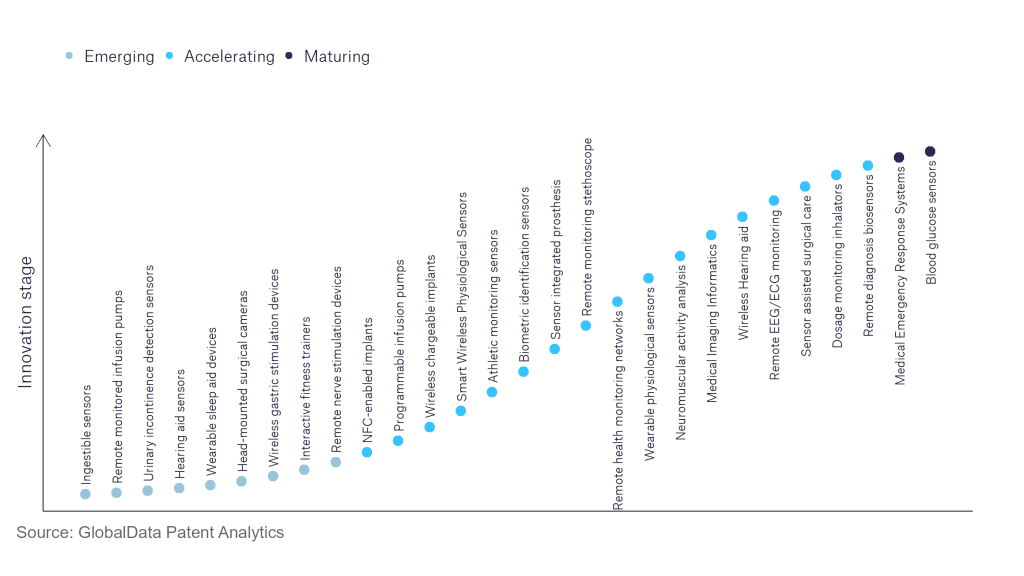The medical devices industry continues to be a hotbed of innovation, with activity driven by increased need for homecare, preventative treatments, early diagnosis, reducing patient recovery times and improving outcomes, as well as a growing importance of technologies such as machine learning, augmented reality, 5G and digitalisation. In the last three years alone, there have been over 450,000 patents filed and granted in the medical devices industry, according to GlobalData’s report on Internet of Things in Medical Devices: Athletic Monitoring Sensors. Buy the report here.

Discover B2B Marketing That Performs
Combine business intelligence and editorial excellence to reach engaged professionals across 36 leading media platforms.
However, not all innovations are equal and nor do they follow a constant upward trend. Instead, their evolution takes the form of an S-shaped curve that reflects their typical lifecycle from early emergence to accelerating adoption, before finally stabilising and reaching maturity.
Identifying where a particular innovation is on this journey, especially those that are in the emerging and accelerating stages, is essential for understanding their current level of adoption and the likely future trajectory and impact they will have.
150+ innovations will shape the medical devices industry
According to GlobalData’s Technology Foresights, which plots the S-curve for the medical devices industry using innovation intensity models built on over 550,000 patents, there are 150+ innovation areas that will shape the future of the industry.
Within the emerging innovation stage, ingestible sensors, wireless gastric stimulation devices, and remote nerve stimulation devices are disruptive technologies that are in the early stages of application and should be tracked closely. Dosage monitoring inhalators, programmable infusion pumps, and athletic monitoring sensors are some of the accelerating innovation areas, where adoption has been steadily increasing. Among maturing innovation areas are blood glucose sensors and medical emergency response systems, which are now well established in the industry.
Innovation S-curve for Internet of Things in the medical devices industry

Athletic monitoring sensors is a key innovation area in Internet of Things
Athletic monitoring sensors comprise wearable and non-wearable sensors, such as cameras, as well as wearable sensors such as heart rate and blood pressure monitors. As people continue to look to track their fitness in real time, these sensors will continue to grow and with their use becoming common across most fitness equipment going forward.
GlobalData’s analysis also uncovers the companies at the forefront of each innovation area and assesses the potential reach and impact of their patenting activity across different applications and geographies. According to GlobalData, there are 40+ companies, spanning technology vendors, established medical devices companies, and up-and-coming start-ups engaged in the development and application of athletic monitoring sensors.
Key players in athletic monitoring sensors – a disruptive innovation in the medical devices industry
‘Application diversity’ measures the number of different applications identified for each relevant patent and broadly splits companies into either ‘niche’ or ‘diversified’ innovators.
‘Geographic reach’ refers to the number of different countries each relevant patent is registered in and reflects the breadth of geographic application intended, ranging from ‘global’ to ‘local’.
NIKE is one of the leading patent filers in the field of athletic monitoring sensors. Some other key patent filers in the field include Adidas, Lululemon Athletica, Koninklijke Philips, and Samsung Group.
In terms of application diversity, Asahi Kasei leads the pack, followed by Fitscript and smaXtech. By means of geographic reach, NIKE held the top position, followed by Amer Sports and Laerdal Medical in second and third spots, respectively.
Athletic monitoring sensors allow athletes to better monitor their health status and help determine how they can train and compete. These sensors also allow healthcare professionals to diagnose any challenges and provide timely treatment. Owing to the fact that these devices are valuable for the improvement of athletes’ performance, the market for these sensors is expected to grow.
To further understand the key themes and technologies disrupting the medical devices industry, access GlobalData’s latest thematic research report on Medical Devices.
Data Insights
From

The gold standard of business intelligence.
Blending expert knowledge with cutting-edge technology, GlobalData’s unrivalled proprietary data will enable you to decode what’s happening in your market. You can make better informed decisions and gain a future-proof advantage over your competitors.




